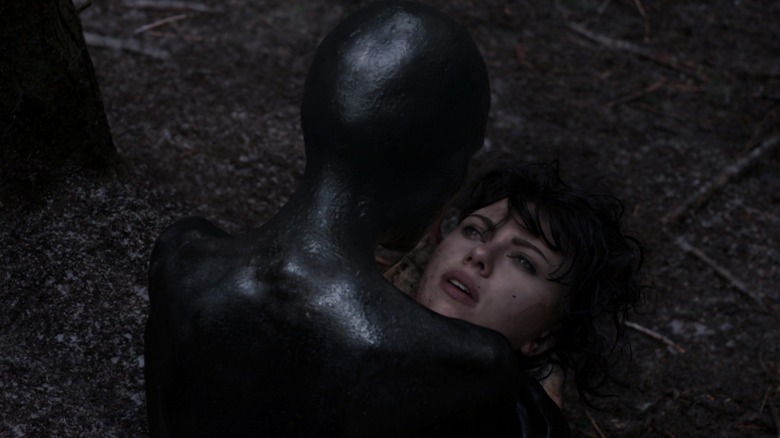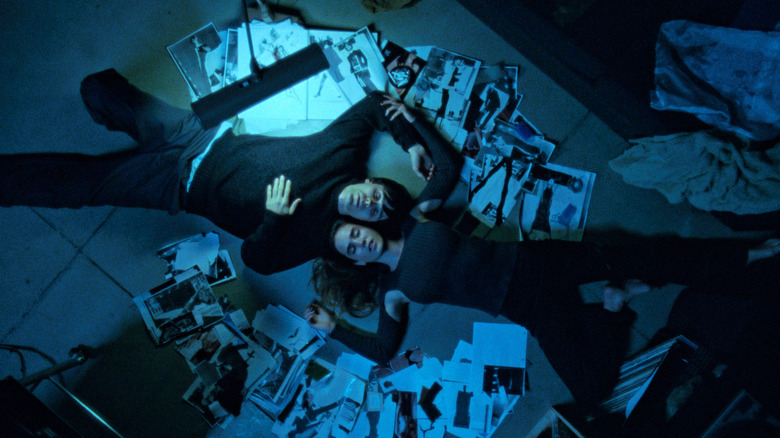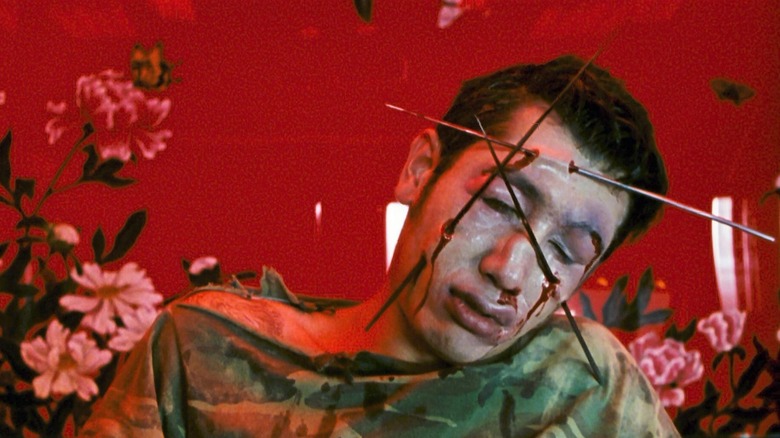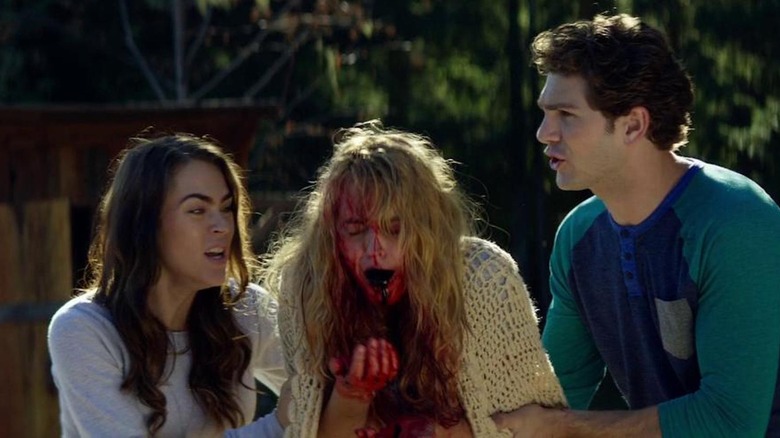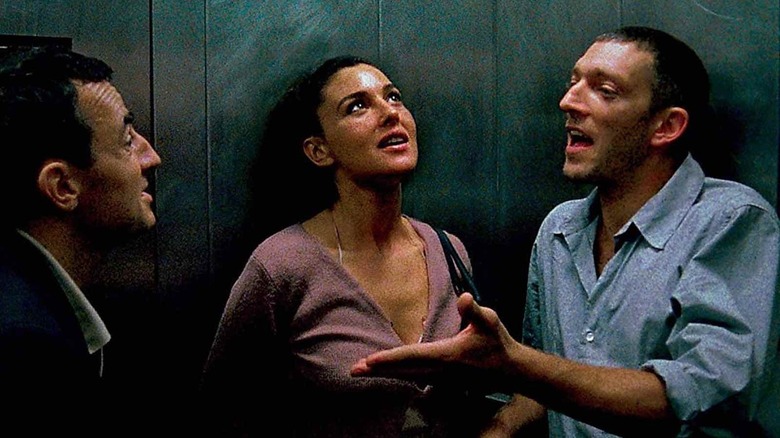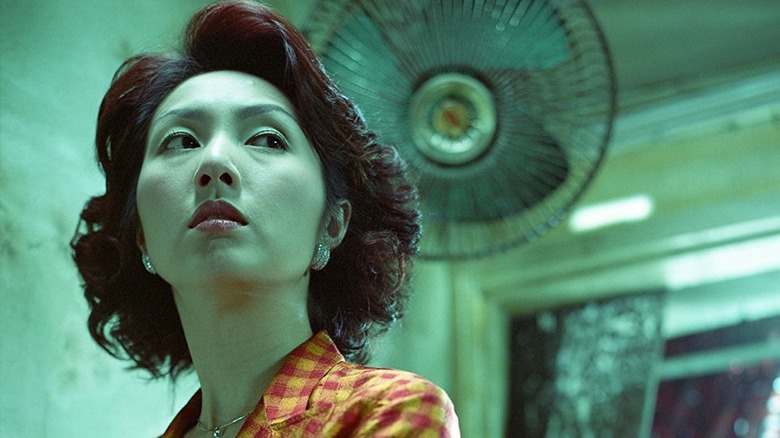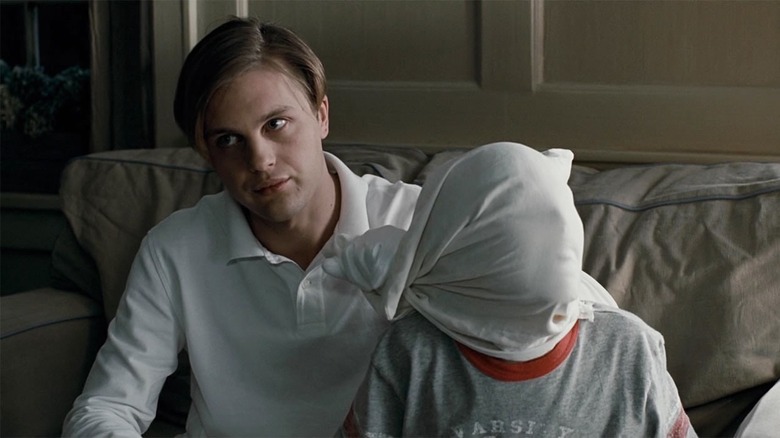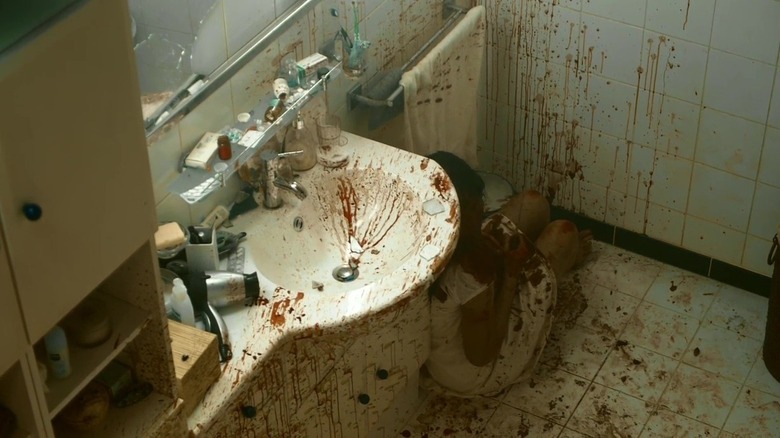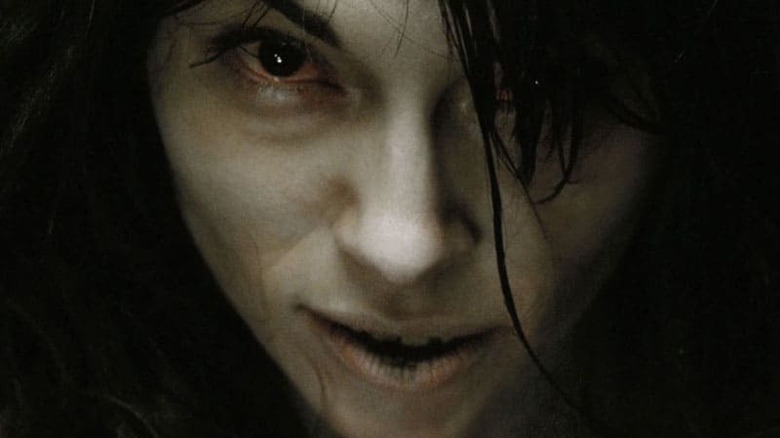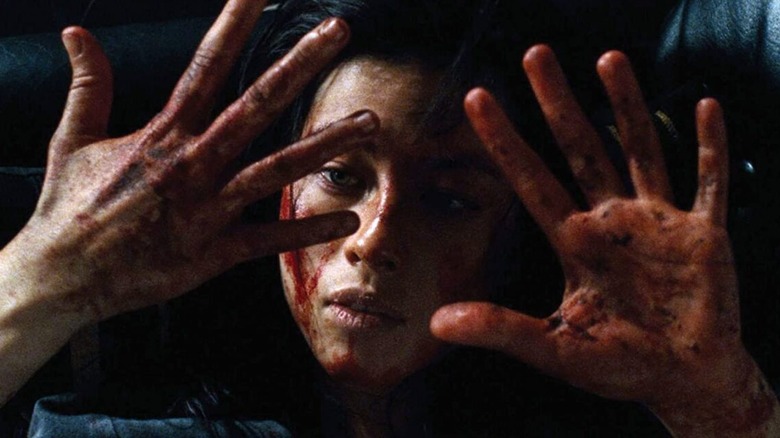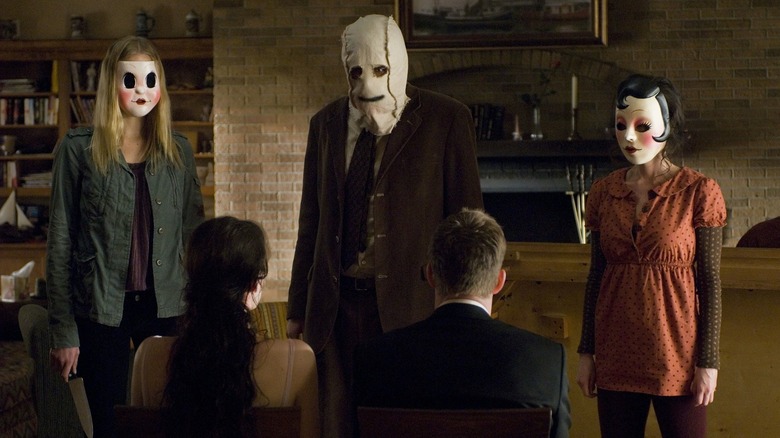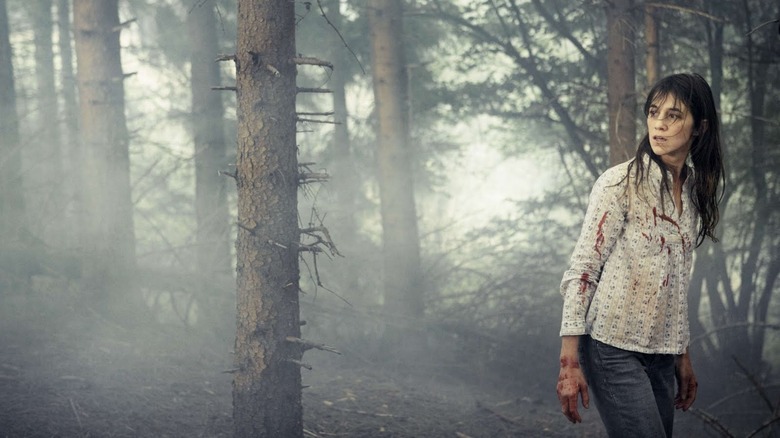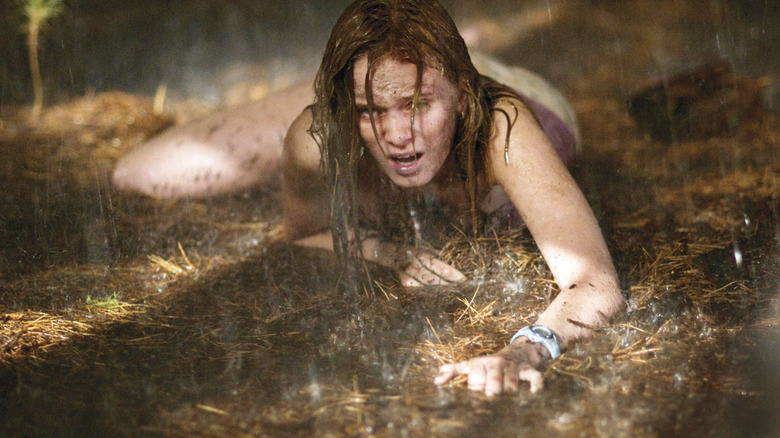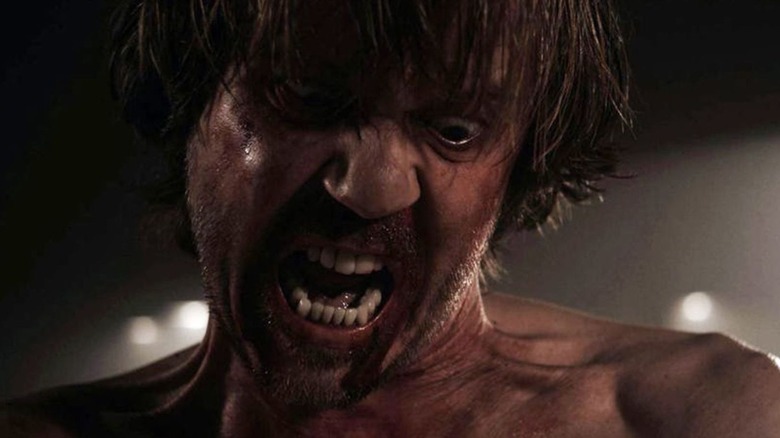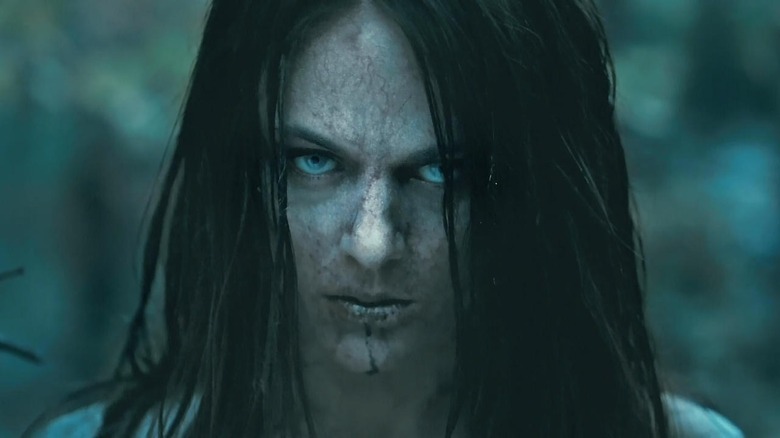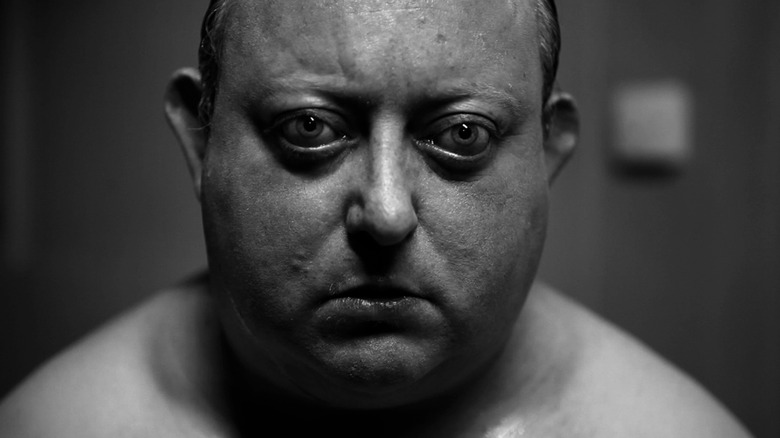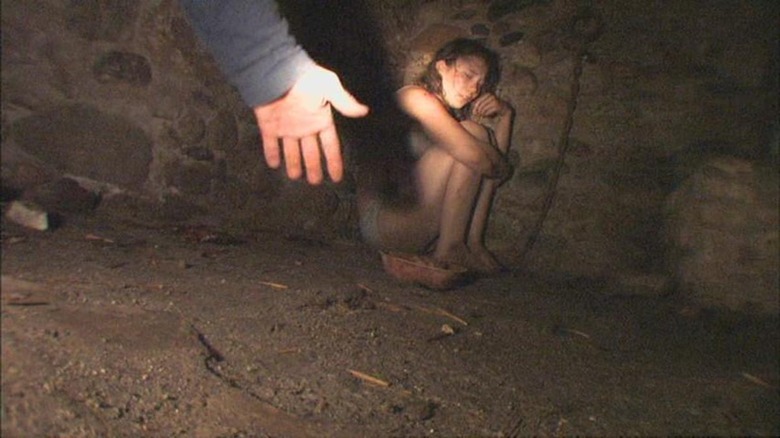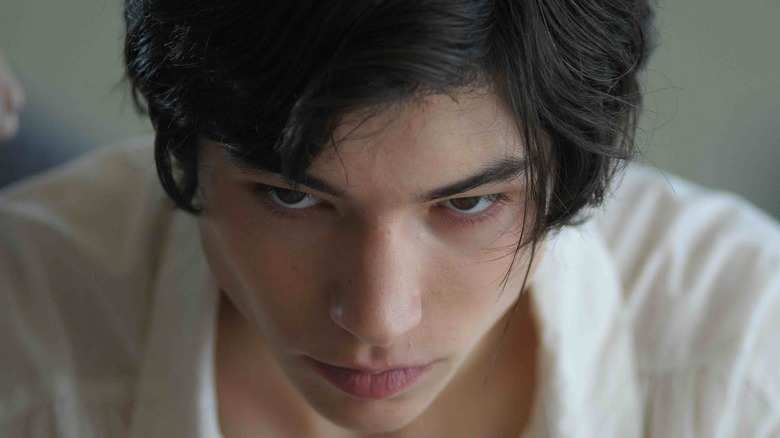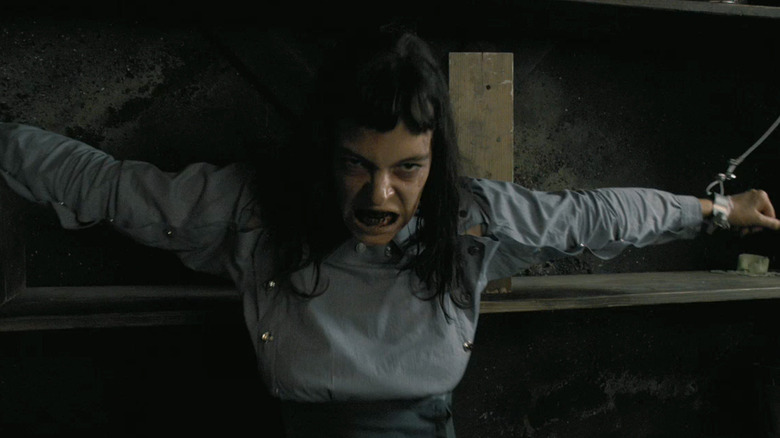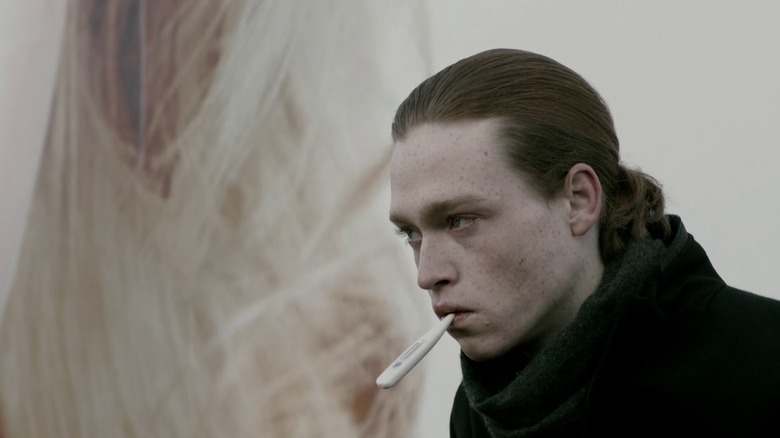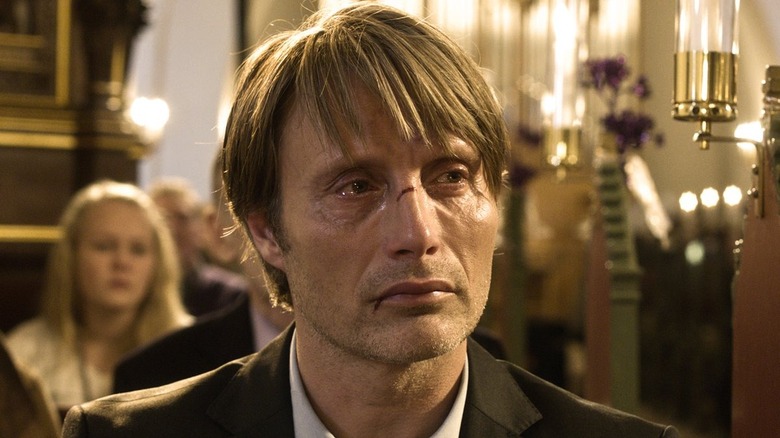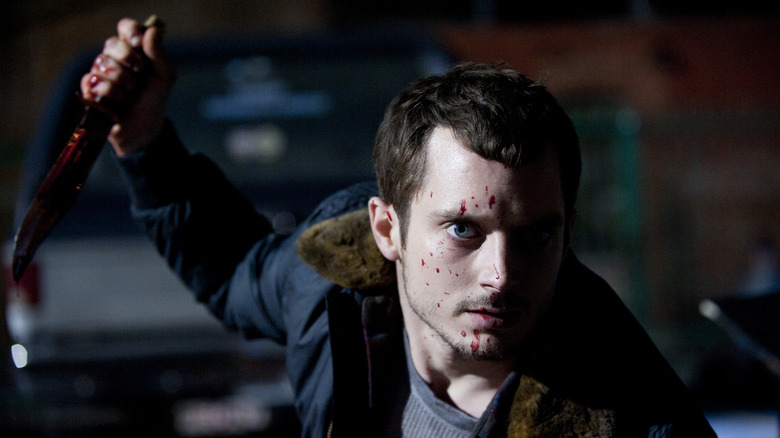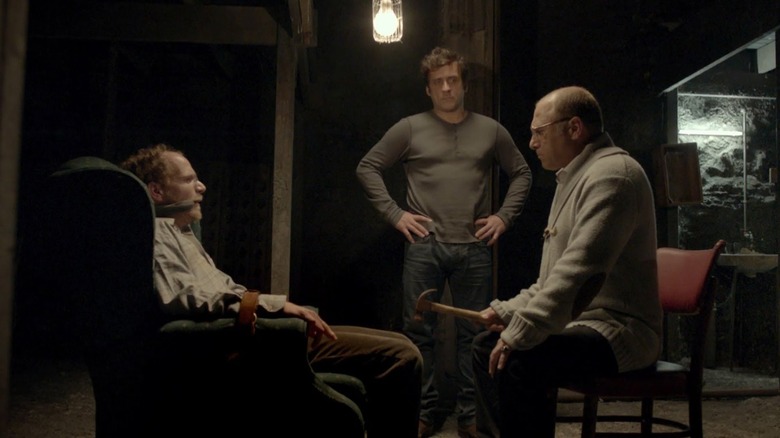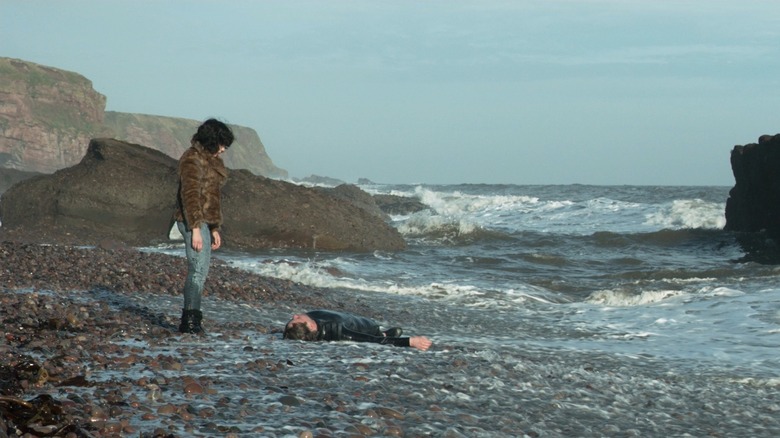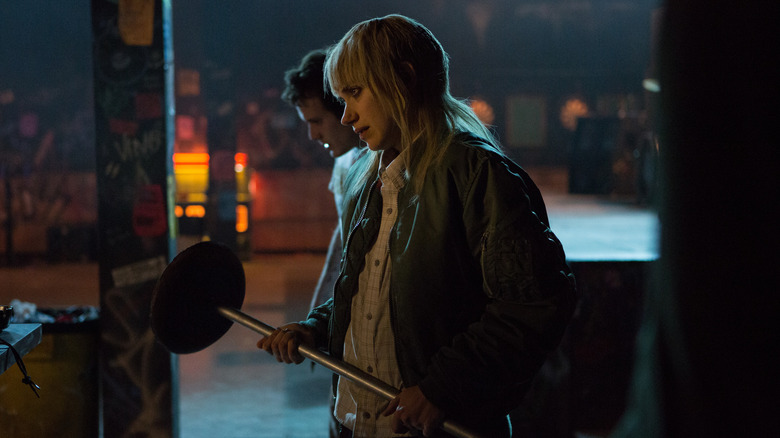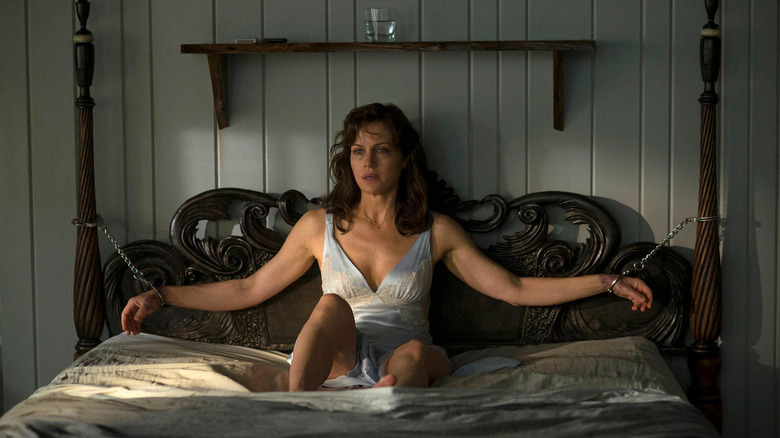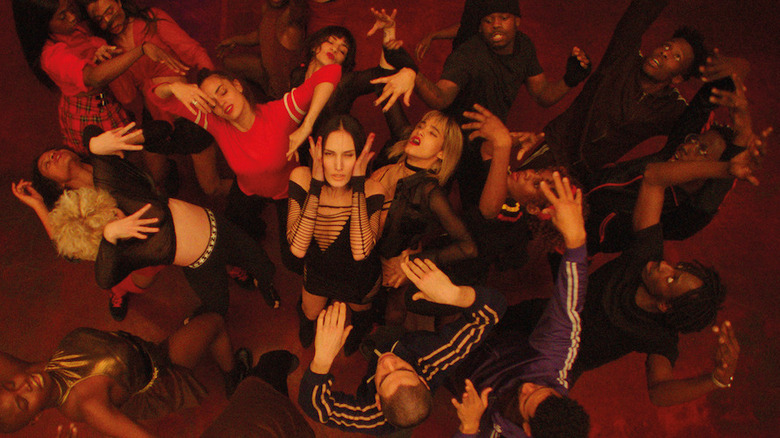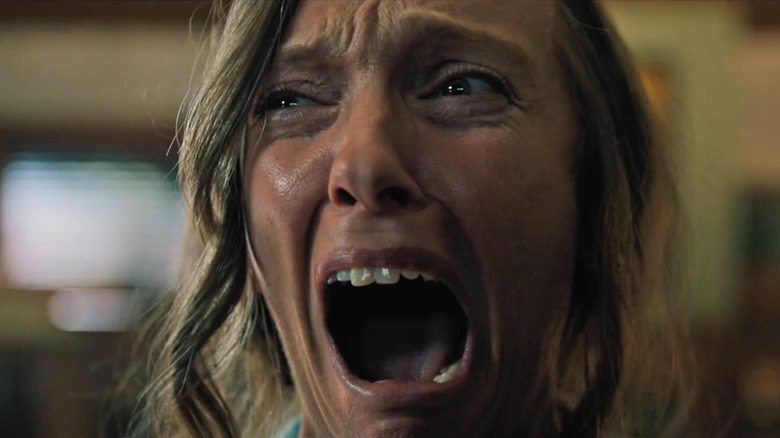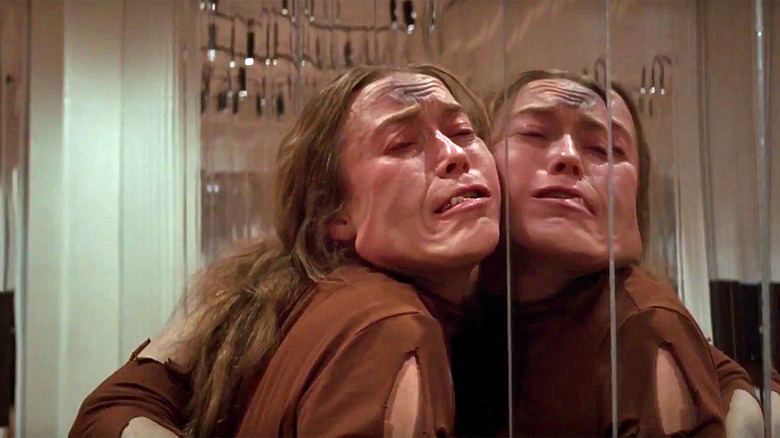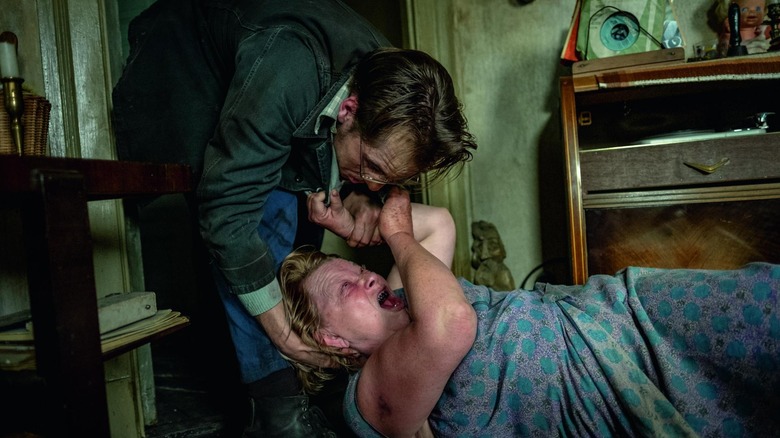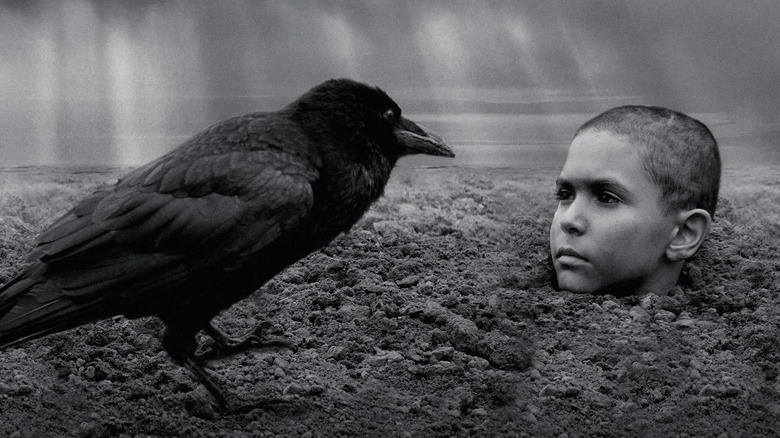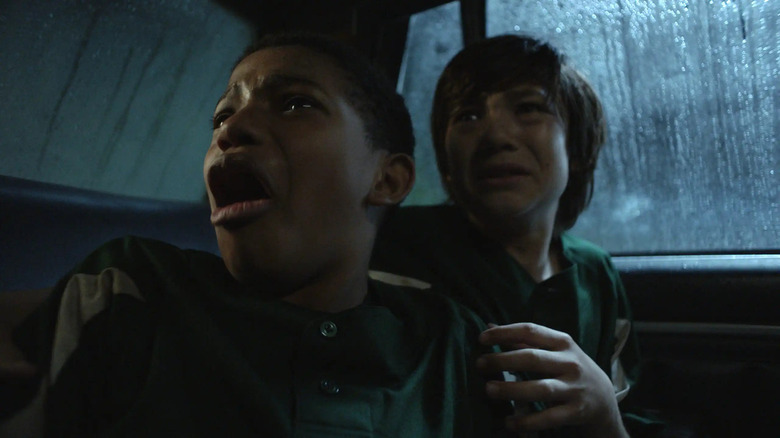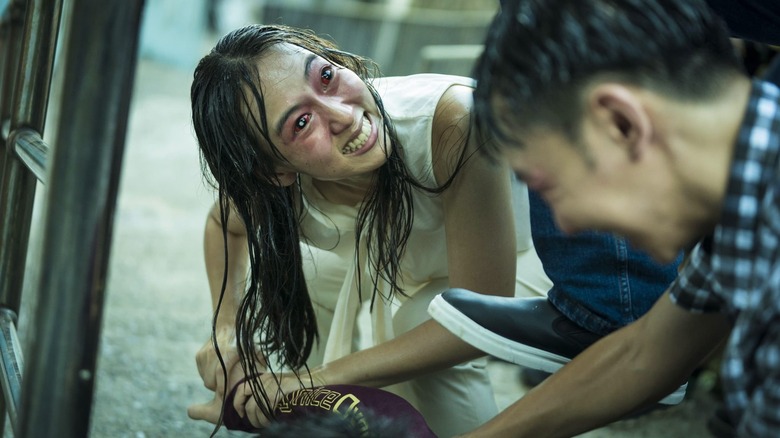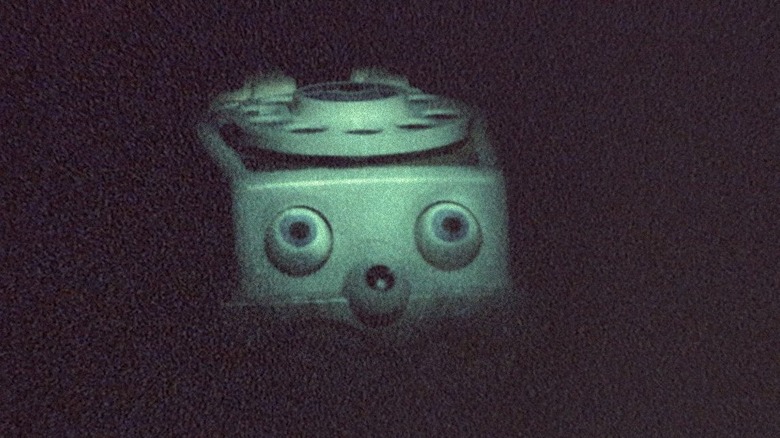These Are The 35 Most Disturbing Movies Of The Century So Far
This is not a fun list.
No, this is not a compilation of movies you casually put on, hoping for a chill time on your couch. You don't watch the films on this list as much as the films on this list happen to you: they slip under your skin, slide into the folds of your brain, worm their way into your very soul. When the /Film team sat down to hammer out a list of the most disturbing movies of the century so far, we drew a hard line. Nothing could make it on the list unless we found it actively unpleasant to experience. There are no cornball haunted house movies or cheesy slashers contained here. This is the real nightmare fuel. The movies that pushed our buttons in profound ways.
Some of these movies are masterpieces. Some are trash we can't really recommend. But all of them are disturbing. Buckle up — this is a rough one.
TRIGGER WARNING: this list contains descriptions of gratuitously graphic and disturbing movie scenes depicting sexual assault, self-harm, torture, murder, and literally anything and everything else you may find upsetting. Proceed with caution.
Requiem for a Dream (2000)
Darren Aronofsky's "Requiem for a Dream" is a horror movie where the demon eating away at its four core characters is addiction. This unflinchingly bleak portrayal of the different ways in which drug abuse can tear people's lives apart is disturbing not because of any extreme violence or gore, but because it might be one of the most depressing movies ever made.
"Requiem for a Dream" begins with Sara Goldfarb (Ellen Burstyn) locking herself in a closet while her heroin-addicted son, Harry (Jared Leto), steals her TV to sell for drug money — and that's at one of the happier points in these characters' lives. By the end of the movie, Harry is lying in a hospital bed with his arm amputated, having contracted gangrene from infected injection sites. His friend Tyrone (Marlon Wayans) is suffering through withdrawals in jail. Harry's girlfriend Marion (Jennifer Connelly) is performing in degrading sex shows in exchange for her next hit of heroin. And Sara is near-catatonic after abusing amphetamines to lose weight for a television appearance that's never going to happen.
In conclusion: Drugs are bad, m'kay? (Hannah Shaw-Williams)
Ichi the Killer (2001)
Hideo Yamamoto is enjoying some celebration lately. His seinen manga "Homunculus" is enjoying a vivid adaptation on Netflix, and is one of /Film's selections for Best Horror Movies of the year. But one of the author's most famous works, about an unstable killer who brushes up against a sadistic Yakuza enforcer, has been shocking people for 20 years. Prolific Japanese director Takashi Miike got his hands on it, and a new flavor of the old ultra-violence was brought to mainstream audiences in the early aughts in a way that most J-horror at the time wouldn't touch.
Like his contemporaries Sion Sono ("Suicide Club") and Kinji Fukasaku ("Battle Royale"), Miike was more interested in criminal underbellies and poking at taboos. He seems to be one of the few filmmakers working who has no problem translating brutalities in manga form (which has considerably different leeways than feature films do) to the screen, carrying tongue mutilations and mid-air suspension tortures from page to screen without batting an eyelash (to the disgust of audiences in 2001 and today). An interrogation scene has its victim tormented with boiling tempura oil and his cheek sewn through. A sex worker is mutilated before her death. Ichi himself gains sexual gratification from killing (though he's a pawn in several senses), and his nemesis carries snake-like slits extending from his mouth — the business of these men is violence, through and through. But it's not entirely the violence that viewers are truly upset with; it's their own inability to look away. Miike knows it, too. (Anya Stanley)
Suicide Club (2001)
Sion Sono's 2001 indie film "Suicide Club" exists at the intersection of two other contemporary Japanese horror movies. It shares DNA with the techno-horror "Pulse," which captured turn-of-the-millennium fears that the Internet could become a terrible force for evil (fears that were validated a few years later when Twitter was invented). And with "Battle Royale," it shares the theme of teenagers dying en masse in gruesome ways.
"Suicide Club" is as bizarre and hard to pin down as it is disturbing, which is perhaps why it never reached the same heights of popularity as either of the aforementioned films. The film follows a group of police officers and a curious hacker who investigate a series of violent suicides that are somehow connected to a mysterious website full of colored circles. In the opening sequence of "Suicide Club," 54 schoolgirls line up on a train platform, holding hands, and collectively jump in front of a train. It's an odd mix of the macabre and the cartoonish as the girls' bodies are shown being crushed under the train and giant waves of blood splash the gathered commuters.
In between these vignettes of violence, "Suicide Club" continually keeps the audience off-balance and guessing right up until the end. Who is leaving grisly rolls of stitched-together human skin at the scenes of mass suicides? Did the suicide victims consciously choose to die, or were they psychologically manipulated? Are the gang of glam-rock sociopaths that live in a run-down bowling alley responsible for the deaths, or are they simply a red herring? Ultimately, "Suicide Club" offers no easy answers. (Hannah Shaw-Williams)
Cabin Fever (2002 and 2016)
Eli Roth might not be your favorite horror director, but no one can deny the staying power of his gruesome romp "Cabin Fever." The sexy, bloody, and downright disgusting 2002 film was popular enough to power two sequels and a 2016 remake. While "Cabin Fever 2: Spring Fever" and "Cabin Fever: Patient Zero" don't quite capture the magic in the bottle that was the original, the remake sticks close enough to what made the 2002 film work that it feels almost as affecting.
The plot of both the 2002 and 2016 movies follows a group of conventionally attractive college students as they head into the woods to vacation in a cabin by a lake. They have a week of drinking, smoking, and sex ahead of them, but that dream is quickly cut short when they all begin to develop a mysterious flesh-eating disease. While both films are filled with more scenes of decaying limbs and oozing blood than you could ever want, there's one scene they share in particular that takes the cake. In it, one of the college girls draws a bath in an attempt to clean her bleeding sores. When she begins shaving her legs, her skin slides off with the razor, revealing a crimson slash of blood and muscle. It will 100% make you never want to shave again. (Kaylee Dugan)
Irreversible (2002)
Gaspar Noé's "Irreversible" so disgusted the gathered audience when it premiered at the Cannes Film Festival that newspaper reports estimated 10% of the 2,400 gathered viewers walked out of the movie (according to Tim Palmer's retrospective on "Contemporary French Cinema of the Body").
Following closely on the heels of "Memento," which was released a couple of years earlier, "Irreversible" is similarly structured with its scenes shown in reverse chronological order. It begins with Marcus (Vincent Cassel) furiously hunting for the man who raped his girlfriend, Alex (Monica Bellucci), and beat her into a coma. The rape itself is depicted midway through the film in a single, grueling, unblinking take, and "Irreversible" is notorious for its similarly dispassionate depiction of a man gradually, brutally getting his face caved in by a fire extinguisher.
What makes "Irreversible" so unique, despite being so hard to watch, is the way in which it turns the usual rape-revenge tropes on its head. The "money shot" (of the supposed rapist's head being crushed) comes at the start of the film, and it's eventually revealed that the man who was killed was not even the man who raped Alex. There's no feeling of catharsis as the movie winds towards its incongruently serene ending — only a growing sense of tragedy as we're shown what no amount of revenge will ever be able to restore. (Hannah Shaw-Williams)
Dumplings (2004)
Fruit Chan's Hong Kong horror film "Dumplings" is one seriously twisted tale of the lengths women will go to in order to maintain the appearance of youth. The movie follows aging actress Mrs. Li (Miriam Yeung), who worries that her husband is losing interest in her and is having a hard time finding roles. She enlists the help of Aunt Mei (Bai Ling), a local woman renowned for her magical regenerative dumplings. The secret ingredient in her dumplings is a disturbing one: she uses human fetuses. Mei also moonlights giving people illegal abortions, which is where she gets her unusual magic ingredient.
Fetus dumplings are pretty horrific on their own, but the situations that drive characters to both provide for them and purchase them are what make the movie so disturbing. Initially Mrs. Li is repulsed by the dumplings, but once she thinks she sees results, she starts asking Mei for more potent recipes, which require even more ethical lines crossed. When one of Mei's patients dies after a botched abortion to "harvest" the most potent medicine for Mrs. Lei, it's hard to stomach more than just the idea of munching on pre-humans. The abortion scene is graphic, and the resulting suffering is even worse. By the time the credits roll, the horrors of anti-choice policies and patriarchal control seem much more disturbing than even this bizarre form of cannibalism. (Danielle Ryan)
Funny Games (2007)
In both writer-director Michael Haneke's shot-for-shot remake of his 1997 horrorshow, the audience is taken down the rabbit hole when a suburban family gets taken hostage in their own home by two men they meet randomly amid their serene lakeside vacation. The captors (played by Brady Corbett and Michael Pitt) invite the family to engage in a bet as to whether or not they will be alive by 9:00 the next morning by taking part in a handful of sadistic games. Sounds pretty unsettling, no? Everything in the film hinges on the sheer terror of invasion, of someone unwanted and forceful taking over your sanctuary. On top of that, the occupation is coming at the hands of unsympathetic psychopaths.
One of the most chilling scenes in this movie revolves around a sickening game the Farbers are forced to play, called "cat in a bag." During the game, one of the assailants holds the family's son captive with a pillowcase over his head while they force his mother (Naomi Watts) to undress while her husband (Tim Roth) watches so they can inspect her body for imperfections. It's gratuitous and sadistic and puts the impulses of these villainous characters on full display. And, what's worse is it is easy to put yourself in the family's shoes. Ultimately, the film is a commentary on violence in media (if you've seen the film, you know why, but for those of you who haven't, I certainly suggest having a watch) — and Haneke makes sure we are haunted by that fact. "Why don't you just kill us?" the mother asks at one point. "You shouldn't forget the importance of entertainment," is the response she receives. (Lex Briscuso)
Inside (2007)
Some folks would have you believe that childbirth is all magical and beautiful. But it's also violent and horrifying. Alexandre Bustillo and Julien Maury's "À l'intérieur" (or "Inside" to English-speaking audiences) takes the turmoil and terror of childbirth, gives it uppers, and parades it around, drenched in blood, with all the lights on. The New French Extremity wasn't known for being subtle, but "Inside" became one of the genre's most definitive examples of how disturbing it could be.
It's Christmas eve (yep, this one's a Christmas movie), and Sarah (Alysson Paradis) is having her baby the next day, four months after surviving a car crash that killed her husband. She's home alone, depressed, reluctant to be a single mother, and terrified of labor (as evidenced by a particularly disturbing dream). Then she shows up.
A strange woman known only as La Femme (Béatrice Dalle) has been stalking Sarah, and she wants to be let into the house. Why? To steal her unborn baby right from her womb with whatever implements are at her disposal.
What ensues is a psychotic, unpredictable bloodbath that's perhaps the most violent and provocative metaphor for the horrors of childbirth ever made. It stunned audiences at its Cannes world premiere and gave TIFF's Midnight Madness regulars a run for their money, raising the bar for disturbing content for years to come.
Some say giving birth is beautiful. "Inside" has other ideas. (Ariel Fisher)
Deadgirl (2008)
"Deadgirl", written by Trent Haaga and directed by Marcel Sarmiento and Gadi Harel, follows two teenage boys (Noah Segan and Shiloh Fernandez) who discover a naked female zombie (Jenny Spain) and take her captive. One of them decides to keep her as a sexual object and starts bringing in other teenagers to have sex with her, despite the fact that she clearly cannot and does not consent. This puts a serious strain on the boy's friendship, and things come to a head when the question of making a new, less decomposed Deadgirl arises.
While "Deadgirl" is a harsh commentary on rape culture, it's also brutal to watch. There are several scenes with teenage boys forcing the zombie girl into sex acts, some of which are rather graphic. Sure, one of the boys ends up with his intestines decorating a bathroom stall, but the gore is not what's disturbing about "Deadgirl." Instead, the callous way the teenage boys treat their undead captive and the living women in their lives is what makes the movie so incredibly unpleasant. Each of them, even the one who seems like he's trying to do the right thing, has a completely damaged view on gender and sex. They don't see women as people, but as sex objects, and their experiences with Deadgirl only bring those horrific attitudes to a head. (Danielle Ryan)
Martyrs (2008)
Depending on who you ask, "Martyrs" was so obliteratingly disturbing and soul-crushing that it effectively ended the New French Extremity, or what may become its first cycle. It's as if all there was left to achieve in the politically and culturally charged subgenre had been accomplished. There was nowhere else to go.
"Martyrs" opens on Lucie Jurin (Mylène Jampanoï), a young girl, escaping a derelict warehouse where she was systematically tortured and abused for more than a year. She's taken in by a local orphanage where she befriends a girl named Anna Assaoui (Morjana Alaoui), also a survivor of child abuse. 15 years later, Lucie is convinced she's found her captors, and she and Anna scope out their home to make sure. Paranoia begets murder which leads to Lucie's mental and emotional annihilation, and Anna's discovery of facts that should have been left undisturbed.
With more tonal shifts than "From Dusk Till Dawn," "Martyrs" is disturbing not so much for its gore as for its bleakness and brutality. It anthropomorphizes intangible notions like guilt and fear, suggesting that the mind, once broken, is irreparable.
The power of "Martyrs" and the reason it's become one of the most infamous titles on this list lies not in the shock value of blood, guts, and gore. It wants to crush your soul and leave you hopeless, and it's more than up to the task. (Ariel Fisher)
The Strangers (2008)
Home invasion horror is nothing new, but director Bryan Bertino gave the genre a particularly memorable entry, one that is disturbing on a purely psychological level with 2008's "The Strangers." Not that killers always need a good reason to do what they do, but at least a little reason helps set up some conflict for the audience. However, this movie becomes so distressing and gut-wrenching toward the end when it's explicitly said that the only reason Liv Tyler's Kristen and Scott Speedman's James became the subjects of a night of unimaginable torture and violence at the hands of three masked killers was simply because they were home.
While Bertino's slow-burn direction and slasher scenes work well, it's that line that re-contextualizes the entire movie for the audience and makes it truly stick. The fact that these three deeply violent people were on the hunt and the only reason those two people had to endure what they endured was that they made the mistake of being home. Few movies have ever made the "it could happen to you" thing stick quite as well. (Ryan Scott)
Antichrist (2009)
An unnamed man and an unnamed woman are suffering. While they were making love in the shower, their unattended five-year-old child climbed out onto their balcony and fell to his death. He is a psychologist and immediately compartmentalizes, pushing his grief down and devoting himself to helping his wife through her mourning. She can feel only hurt.
They retire to a cabin in the woods to heal, only the cabin is not too many steps removed from something one might see in an "Evil Dead" movie. As the two explore their sadness, they merely sink deeper and deeper into depression. She begins saying things like "Nature is Satan's church," and equates sex to death. His patronizing healing efforts also reveal a curious link to the history of men trying to cure "hysterical" women. By the film's end, their hopelessness and growing nihilism explode into several acts of horrifying sexual violence.
The most chilling thing about "Antichrist" is that it may actually be recognizable. Not the torture or the death or the talking foxes that declare "Chaos reigns." Anyone who has suffered from extreme depression may recognize the film's bleak worldview. The world has become dark and full of death. Nature is inhospitable and wants living things to eat themselves. Earth is capable of nothing but destruction and misery and sorrow, and male-kind would have no solution than to shunt all Earth's negativity into womankind. Everything else has vanished, and sadness is all that remains. (Witney Seibold)
The Last House on the Left (2009)
In this remake of Wes Craven's 1972 exploitation rape-revenge thriller of the same name, 2009's "The Last House on the Left" tells the story of a girl named Mari (Sara Paxton) and her friend Paige (Martha MacIsaac) who cross paths with escaped convict Krug and his crew of criminals who kidnap the girls, assault Mari, and leave them both for dead. In a twist of fate, the crew ends up seeking refuge at Mari's family lake home in the middle of a storm, and her parents John and Emma (Tony Goldwyn and Monica Potter) unwittingly offer them shelter. Once the duo discovers just who these strangers are, they decide to enact revenge on them for harming their daughter, taking justice into their own hands.
"The Last House on the Left" is disturbing not only for its subject matter which deals with rape, torture, and extreme violence but also the generational trauma that exists once we realize Krug is trying to convince his teenage son to join in on his sick and demented excursions of horror. Additionally, watching John and Emma process the truth of what has been done to their daughter is heartbreaking and forces the audience to witness not just a terrible event, but the ripple effects of the harm caused. The parents' vengeance is to be expected, but the performance of Sara Paxton after her character is assaulted is extremely difficult to watch, and a painful reminder that far too many people have survived similar attacks. (BJ Colangelo)
A Serbian Film (2010)
Where to even start with this one? "A Serbian Film" is one of the most difficult movies you will ever try to sit through. Not in terms of quality, mind you. It's a well-crafted film. In terms of content, though ... Hoo, boy.
The story revolves around a retired porn actor named Milos who takes one last high-paying job that is sold to him as the biggest, most artistic adult film ever made. This isn't to be a traditionally-shot film, but one that strives for naturalism above all else. Milos is just to live his life and at certain points "actors" will show up and initiate the sex scenes. Think of "A Serbian Film" as the most extreme version of David Fincher's "The Game" and you're close to the tone here. The weirdness escalates until lines are crossed. Like ... all the lines you think you know about and then a few more lines you never knew existed. All of them. Crossed
The most infamous scene in the movie, the one that probably cemented this film's position on this list, is when Milos realizes he's signed up for something he's in no way prepared for. His mysterious and rich benefactor shows him footage of a birth and then the subsequent rape of the newborn baby. Now, this all happens off-screen, but just the idea that it's portrayed at all was enough to get this movie banned in multiple countries.
Now, the craziest thing about "A Serbian Film" is that the infamous scene mentioned above isn't even the worst thing that happens in the movie. The ending is even harder to stomach. So bleak and disgusting and dehumanizing. "A Serbian Film" is a movie that is hard to sit through and impossible to recommend to just about anybody. It's the rare "extreme" film to earn its label. (Eric Vespe)
I Spit On Your Grave (2010)
The original 1978 rape-revenge film "I Spit On Your Grave" is one of the most infamous exploitation films in history. It's almost unthinkable to imagine remaking a film of this caliber, but that's exactly what happened in 2010. A novelist named Jennifer travels to Louisiana to work on her next book in peace, but is brutally attacked and raped by a group of men who felt embarrassed by her rejection of their flirtation. When Jennifer looks to law enforcement for help, the men reappear and instead of helping her, the sheriff joins in on her continued assault. The men leave Jennifer for dead, but she miraculously survives and begins stalking her assailants to plan her revenge. What follows is brutal and personalized retribution, with Jennifer fulfilling acts of brutality beyond imagination.
What makes the 2010 version of "I Spit On Your Grave" so disturbing is the fact the film's existence proves that there's still a need for the cathartic release of rape-revenge films over three decades from the original's release and that the situation surrounding Jennifer's attack is still alarmingly relatable. A man gets his eyes pecked out by birds, another has his face burned off with lye, another is emasculated and left to bleed to death, and the final two are killed by a shotgun inserted into a man's anus with the bullet exiting and landing into the chest of the other. Their deaths are horrific, but after seeing the harm they've caused, it's almost impossible not to wish them worse. (BJ Colangelo)
The Human Centipede 2: Full Sequence (2011)
"The Human Centipede" is about a deranged doctor obsessed with the idea of connecting humans who surgically attaches three people by the digestive tract, mouth to anus. "The Human Centipede 2" is about a man named Martin Lomax that is so obsessed with the film he sets out to make his own centipede consisting of 12 people, including Ashlynn Yennie, an actress from the first film. After kidnapping, knocking out teeth, and crudely attaching his victims in a centipede formation with a staple gun and duct tape, he injects them with liquid laxative causing, well, exactly the kind of explosion laxatives are made for.
Even today, "The Human Centipede 2" cannot be legally supplied anywhere in the UK after The British Board of Film Classification deemed it "sexually violent and potentially obscene" with "unacceptable material" that cannot be fixed with cuts. "The Human Centipede 2" is not for the faint of heart, but the most disturbing fact is that someone like Martin probably exists, meaning, there has to be someone out there absolutely obsessed with "The Human Centipede." Every movie is somebody's favorite movie, and that goes for "The Human Centipede." Thinking about that possibility is enough to make someone want to immediately take a shower. (BJ Colangelo)
Megan is Missing (2011)
Michael Goi's found footage psychological horror film "Megan is Missing" is infamous at this point, often shared as part of a viral endurance test to see how long people can last watching the film before they tap out. The film was banned in New Zealand upon release for its graphic depictions of sexual violence and torture, and the director has talked at length about how the film's continued virality among teenagers is bothersome because he made the film as a wake-up call to parents who allow their kids unfiltered access to the internet. The film follows a young girl named Megan who disappears after talking to a stranger online, and the search efforts conducted by her best friend Amy.
What follows is one of the most depraved scenarios imaginable. Images and videos of Megan being tortured end up on fetish forums online. The man who Amy believes to be Megan's kidnapper eventually tracks her down and holds her hostage as well, torturing her in ways that make the "Saw" films look like family films. Due to the found-footage nature of the film, it's easy to forget that you're watching something scripted and haven't accidentally stumbled onto a cursed forum online. This film is a parent's worst nightmare come to life, and as Goi based the film's events on real-life crimes, it makes it that much harder to watch. (BJ Colangelo)
We Need to Talk About Kevin (2011)
Horror movies trade in gradual, compounded ignorance of warning signs. Sometimes they'll even warn you in the title, as the '79 disco-horror "Don't Go In The House!" can attest (itself an honorable mention in the disturbing movies pantheon). In Lynne Ramsey's slow-burn psych-drama "We Need to Talk About Kevin," former writer Eva Khatchadourian (Tilda Swinton) is the one to look back on the signs that her son Kevin (played by Ezra Miller) is a sociopath in the wake of a school massacre he carried out that killed several classmates and faculty. Based on the 2003 epistolary novel of the same name by Lionel Shriver, the story unsettles not by its most salacious acts or any sort of gore — quite the opposite. There is a banality to every sign of things to come, and with no accompanying score most of the time, Ramsey draws menace from the silence.
Eva has always struggled to connect to Kevin (she did not want to be a mother), but when things progress beyond late-stage bedwetting, a layer of dread fills the tonal space where jump scares and boogeymen normally dwell. The flags get red: one of Eva's motherly memories that live in cinema infamy is shocking not for the masturbatory act she witnesses, but for the simple thing Kevin does once he realizes he's caught.
A devastating climactic reveal that would normally get an orchestral crescendo is only accompanied by the quiet spritz of the lawn sprinkler system. In large part due to Miller's vacant-eyed, intense performance, "We Need To Talk About Kevin" stays on the mind post-credits not with a scream, but with an insistent whisper. (Anya Stanley)
The Woman (2011)
Lucky McKee earns a spot on this list because "The Woman" is a backwoods tale of relentless misogyny mixed with graphic cannibalism. McKee adapts his novel with co-writer Jack Ketchum — a sequel to McKee's 2009 film "Offspring" — into an imprisonment thriller about a feral cannibal imprisoned by an upstanding family in another pleasant-as-punch, picturesque community with dark, disturbing secrets. The Creek family essentially abducts The Woman, played by Pollyanna McIntosh, and desires to civilize her as this initial good samaritan idea. That is, which you can presume, not what occurs.
As revealed, the Creeks themselves have lessons to learn because once they're out of the public eye, their smiles turn crooked, and family members direct hatred onto the woman restrained on their property. Gingerbread cookies are offered only as a false olive branch to clamp nipples with pliers, for example. McIntosh's in-context innocent party is physically tortured, inappropriately abused, and treated like an animal captured by womanizing demons wearing flesh suits who otherwise act like pillars of society. There's a proper finale where The Woman finally gets her revenge, but the horrors of humankind are what make this tough-to-stomach torture flick so unsettling — a redefinition of the word "monster." You'll be sure to question what your neighbors are capable of behind their white picket fences and hospitable demeanor after watching this midnighter, which is one despicable life lesson. (Matt Donato)
Antiviral (2012)
In the near future of Brandon Cronenberg's "Antiviral," celebrity obsession gets taken to its most extreme ends. Fans can purchase cloned meat of their favorite celebrity to cook up for the family barbecue, or if they're feeling especially adventurous, they can inject themselves with the illnesses taken directly from those same celebrities. That's right: they want to be so close to their celebrity idols that they willingly make themselves sick. In 2021, that seems even more insane than it did back in 2012, before the global pandemic.
An employee for the company that creates these products, Syd March (Caleb Landry Jones), tries to exploit the system and make a little extra money. He injects himself with some stolen product only to discover that it's the same disease that just killed international superstar Hannah Geist (Sarah Gadon). He is forced to solve the mystery behind the celebrity virus market, or else he'll meet the same fate.
"Antiviral" is shocking because it's not only gross (Cronenberg does his father proud, and there's plenty of body horror and practical effects on display), but the concept itself is innately disturbing. The idea of taking a parasocial relationship to the point of consuming your favorite stars or injecting their illnesses into your own body is a next-level dystopian nightmare. (Danielle Ryan)
The Hunt (2012)
If this were a list of most disturbing plays ever written, Arthur Miller's "The Crucible" would have to be on it. It has everything: power-tripping authority figures, mass hysteria, profound injustice, and, most haunting of all, it's based on a true story. The ending of "The Crucible" — in which rebellion stirs as people realize the injustice of the trials and executions, and the witch-hunters find themselves on the verge of being torn apart by the angry mob that was once their ally — sugarcoats the truth. As history tells it, there was no great rebellion; the court was disbanded only when the governor's own wife was accused, and the last of the Salem "witches" wasn't pardoned until 2022.
Danish filmmaker Thomas Vinterberg similarly found himself softening the edges of reality with his 2012 film "The Hunt," in which Mads Mikkelsen plays a kindergarten teacher who is falsely accused of molesting the children in his care. His life is dismantled as friends and neighbors turn on him, the idea that a monster has been in their midst all along spreading like a virus through the community. Vinterberg pieced the story together from real-life cases in a file sent to him by a psychiatrist, who urged him to make a film about the phenomenon of false memories and mass hysteria. But in places, Vinterberg had to pull back. "Reality is much more grim," the filmmaker explained. "This is the airplane version."
If "The Hunt" is the airplane version, it's hard to imagine just how horrifying the real case files were. The story that unfolds is maddening, torturous, enraging – all the more so because the "villains" are fundamentally good people who sincerely believe their campaign of terror is a righteous act. (Hannah Shaw-Williams)
Maniac (2012)
Franck Khalfoun's "Maniac" remake is somehow more disturbing than its 1980s original. William Lustig's "Maniac" is a cesspool of back-alley New York City sleaze and Tom Savini's practical goriness on its own pedestal. Still, Khalfoun — alongside writers Alexandre Aja and Grégory Levasseur — take an approach that's so vile, and so repugnant. Elijah Wood stars as Frank, a serial slasher with traumatic mommy issues who stalks women, viciously murders them, and steals their scalps for his mannequin collection. Hunting knives are plunged into mouths like an uppercut, hands constrict around necks as eyes bulge, and all because Frank is able to wear his "nice guy" personality like a mask in public.
The film employs first-person cinematography that inserts us into Frank's skin. We can hear his heavy panting, listen to his deranged thoughts, and become a slasher villain as asphyxiating, mutilating violence plays out with such unforgiving brutality on the screen. We're allowed into the inner workings of a madman, and dare I say there are brief, fleeting moments of empathy — I know, it's a nasty narrative trick. Expect the kind of horror experience that requires an acid bath afterward to feel clean again, which is intended as a compliment. It's as effective as it is revolting, which is precisely the intention of a remake that doubles the ante in the best-slash-worst ways. (Matt Donato)
Big Bad Wolves (2013)
When a movie is stamped Quentin Tarantino's favorite of the year, you know it's going to be something a bit twisted. Aharon Keshales and Navot Papushado's Israeli tale of not-so-storybook revenge, "Big Bad Wolves," is about three men (and a later interrupter), a dead child, and a toolbox full of torture devices you can find scattered around any average homeowner's garage. It's a scenario of no escape, utter malice, and ignorable remorse when it comes to vigilante justice. There are no heroes in sight.
The father with nothing to lose who recently buried his headless kin. The renegade detective who'll skirt the system for bloody justice. They both believe the man they render immobile is a perverted kiddie killer, and there's no limitation to their methods of coaxing an ultimate admission. That's all "Big Bad Wolves" requires to summon the absolute worst characteristics of humanity pushed beyond their breaking points. It's never about "torture porn" gross-outs inflicted upon the suspect in question, who begs for mercy and cries about innocence. That's the sickest aspect. "Big Bad Wolves" is a devastating and unfathomably stone-cold vision of retribution that only sees red and ponders what good comes out of mending our broken souls with personal, intimate acts of exceptional rage. (Matt Donato)
Under the Skin (2013)
Jonathan Glazer's bleak sci-fi horror mash-up "Under the Skin" doesn't have much in common with its source material. In the similarly titled book, author Michel Faber paints a cold and cruel Scotland infiltrated by a strange alien race that is solely interested in breaking humans down into meat, a delicacy on their alien planet. It's a strange, long, and appropriately sad metaphor for factory farming, but "Under the Skin," the movie, truly cuts out all of the fat. Instead we're left with a film thats primary goal is to manufacture unease and dread.
Scarlett Johansson plays an unnamed woman who drives through Scotland, abducting male hitchhikers and trapping them inside the strange void within her house. Those scenes alone are disturbing, as the hitchhikers leer and make moves on Johansson's character. The audience knows she's essentially a venus fly trap about to swallow them whole, but they still act like they're the predators. In one particularly disturbing scene, a swimmer on a cold Scottish beach attempts to save a drowning couple as the pair's infant baby watches from the sand. After he fails, Johansson's character attacks him with a rock and drags his body off the beach, leaving the baby to succumb to the elements. Glazer lingers on the child, crying and alone on a cold, dark and rocky beach. Glazer never shows the baby's dead body, but those cries, those desperate screams, can't help but stay with you. (Kaylee Dugan)
Green Room (2016)
Director Jeremy Saulnier's horror/thriller "Green Room" is remembered by those who have seen it for a great many things. It is one of Anton Yelchin's final performances, Sir Patrick Stewart transforms into a murderous neo-Nazi, and it is unquestionably disturbing from the moment the plot truly kicks in. Centered on a punk band playing a gig at a Nazi club so that they can get gas money to drive home out of desperation, they unwittingly stumble upon a dead body, which leads to some of the most intimate and tense violence of recent memory.
It's the movie's intimate setting and Saulnier's use of the space that makes the audience feel trapped right along with the band that makes this all so difficult to watch. Several scenes will stick with the viewer long after the house lights go up. A man sticking his arm out of a door only to have it nearly hacked off by a machete, made oddly more disturbing by what we don't see. A dog ripping out a girl's throat and leaving her to gargle on her own blood rather than kill her quickly, simply because a later time of death is more convenient for the people who need to cover up these murders. And a girl who was relatively innocent earlier in the day reduced to cutting a man's stomach open — very slowly — top to bottom with a box cutter. It is all, in a word, brutal. (Ryan Scott)
Gerald's Game (2017)
Jessie and her husband, Gerald, plan a sexy weekend getaway as a last-ditch attempt at rekindling the fire of their marriage. The only problem is Gerald has himself a heart attack while engaging in some light bondage, leaving Jessie handcuffed to her bed alone with the corpse of her husband and no neighbors within earshot. Can she get herself out of this situation before she dies of dehydration? And is that towering figure she sees in the shadows at night really there or just a delusion of her perpetually panicked mind?
Mike Flanagan's adaptation of what was assumed to be one of Stephen King's most unfilmable stories is a soaring success, thanks in no small part to Carla Gugino's strong central performance. Getting out of her current situation depends on her confronting some buried trauma from her childhood, which is disturbing in and of itself when shown in flashbacks. But when you add in a disfigured apparition that shows up in her room and the climactic, dizzyingly gory solution to get herself out of those handcuffs ... you get a movie that manages to get under your skin and stay there.
On a deeper emotional level, any time sexual trauma is tackled in a film, it's going to be difficult for the viewer, so "Gerald's Game" is a double threat in terms of putting you on edge. It'll hit you emotionally and then when the big gore moment comes in, you'll be squirming on your couch, daring yourself to look at the screen. The term "degloving" will forever skeeve you out after watching this movie. (Eric Vespe)
Climax (2018)
Gaspar Noe is known for his violent imagery and unsettling premises, but 2018's psychological horror "Climax" is a horse of a different color in the way it subverts the unexpected and the conventional at the same time. The film zeroes in on a stylish and wild French dance troupe who have taken up residency for the night in an abandoned school building — which allows them to get their party on all night long, should they choose to. The rager-cum-rehearsal takes a turn for the worse when the dancers realize their punch bowl has been spiked with LSD. In an effort to figure out the how and why, their night of fun spirals into a horrific and blood-spattered nightmare, which unfolds as tons of little vignettes filled with terror, betrayal, and rampant, unchecked human nature.
During one particular scene that will leave you harrowed, an agitated dancer brutalizes her pregnant cohort, whom she doesn't believe is with child. After being kicked repeatedly in the stomach, the pregnant dancer is taunted by the full group and, after punching herself repeatedly in the stomach and slashing her own face, encouraged to kill herself. There is validity in the adage that says inebriated musings are sober truths — but if it extends to nights like these, you can keep it, Mr. Noe. (Lex Briscuso)
Hereditary (2018)
The difference between a scary movie and a deeply disturbing movie is all in tone, and "Hereditary" gets you from frame one. Ari Aster's slow push-ins and smooth camera moves underline the horror of "Hereditary" in much the same way Stanley Kubrick's technique made "The Shining" the iconic horror film it is.
Familial trauma is a common thread in Aster's films, and holy smokes is it front-and-center in this story about the shattering of a family already on thin ice. Toni Collette stars as the matriarch of the house, whose family is targeted by some kind of occult force after the death of her mother. The whole movie is a descent into madness for her character as she's hit by tragedy after tragedy that culminates in one of the tensest finales of any modern horror film.
There are precious few jump scares on display. Instead, Aster wants to work his way under the viewer's skin. He'd rather hold on a wide shot and let the audience spot something creepy as hell in the background than have something jump at the lens with a big musical stinger. Alex Wolff and Milly Shapiro are wonderful as brother and sister. Shapiro's Charlie is an odd duck even at the best of times, and her tic, which is a clucking of her tongue, becomes the creepiest movie sound this side of the croaking ghost in "Ju-On: The Grudge."
Wolff is the central focus of most of the disturbing moments in the movie, which isn't gory or hyper-edited. It's simply a long, slow push-in on his face as he's sitting in the driver's seat of a car, trying desperately not to look in the back seat.
"Hereditary" is top tier classy horror guaranteed to mess up your evening. (Eric Vespe)
Suspiria (2018)
Any film about a cult of murderous witches who happen to be mentors at a dance company is sure to spark anyone's interest. I mean, read that sentence again. But where 2018's "Suspiria" remake takes things to the next level is in its ability to make that group of murderous witches terrifying, not campy. The film follows a dancer named Susie (Dakota Johnson) who comes to Berlin to audition for a renowned dance company helmed by Madame Blanc (Tilda Swinton). When Susie's cohorts start crying out witchery and disappearing, she takes it upon herself to figure out what exactly is going on.
This movie banks on the brutality of its antagonists — and if you've seen it, you already know what scene is the best example of this. Yeah, it's that messed up. One of Susie's groupmates accuses the matrons of the company of witchcraft and she storms out of a rehearsal ... only to be trapped in a room where she is unable to stop her body from being crushed and mangled by Susie's powerful (and seemingly magical) performance in the rehearsal above, which appears to be orchestrated by the company's coven. It is hypnotic and nauseating, and you will never look at body horror quite the same way again. (Lex Briscuso)
The Golden Glove (2019)
"The Golden Glove" enjoys a singular achievement in the drama genre, drawing its audience into a fully realized world — behind a repellent character. It's a routine move in the horror genre, where storytellers are more insistent that we identify with monsters, or at least observe them in their natural habitat. Such is the case with Fatih Akin's adaptation of Heinz Strunk's novel "Der Goldene Handschuh," about German serial killer Fritz Honka.
Played by a hunched, lumbering Jonas Dassler under incredible prosthetics, Honka creeps through Hamburg's red-light district and picks up women victims, who are depicted wretchedly by Akin. What he does with them is captured by the film's unforgiving lens, which refuses to look away or give its victims dignity as they die — one unmistakably soils herself as she's being strangled to death. There is nothing nice about the story because the story is not nice: a man chopped up sex workers and hid them in his apartment, and was only discovered when firefighters found a female torso while responding to a fire in his building. There is nothing "transcendent" about the violence, it just is, as well as the collective inherited trauma of post-WWII West Germany. "The Golden Glove" is an ugly movie about a foul man in a filthy, ashamed world. (Anya Stanley)
The Painted Bird (2019)
Set in the unnamed barren hinterlands of a war-torn Eastern Europe, a young boy lives in a miserable cabin with his cruel, elderly aunt. He awakens one night to find that she has died in her chair, an expression of panic frozen on her face. Startled, the boy knocks over her lantern, burning down his house. Alone and homeless, the boy takes to the countryside, seeking someone to care for him. Every person who takes him in, however, is a walking embodiment of pain, guilt, hopelessness, and cruelty. His first caretaker throws him into a river for bringing bad luck. A larger family reveals to be rife with infidelity, and the patriarch removes his own eyeballs. The boy sees a hanging, the death of a horse, and the encroaching line of WWII combat. He is also sexually assaulted by an older woman and beaten by antisemites. He eventually commits murder and forgets his name.
The title comes from an old sage who shows the boy nature's tendency toward sadism. When one paints a bird on the wing, it can no longer rejoin its flock. The other birds attack and kill it.
Many go to the cinema for catharsis, for a message, for a philosophy, for hope. "The Painted Bird" is a piece of cinema devoted to mourning and pain. It's a litany of suffering and an aggressive poem devoted to the futility of life. It's exhilarating. (Witney Seibold)
Parasite (2019)
Much attention has been paid to Bong Joon-ho's "Parasite" as a satire on class and capitalism. Its most enduring meme — of a wealthy and elegant woman complaining on her phone in the back seat of a car, bare feet propped up on the back of the seat in front of her, unaware of her chauffeur's slumped expression of weary contempt — instantly communicates a very specific idea even to people who have never seen the movie.
Though it's not strictly speaking a horror film, "Parasite" is punctuated with imagery that's by turns stomach-churning (if you're sensitive to head injury scenes, you're in for a rough ride) and nightmarish (there's a truly unforgettable shot of someone emerging from a flight of stairs). But more disturbing than any of this is the tragedy of, as Bong himself describes it, "the have-nots and the needy clawing at each other and hurting one another."
"Parasite" hits hard because there's something profoundly real hidden away inside the farcical, tragicomic tale of the working-class Kim family scheming to siphon a living from the ivory tower of the Park family. The characters are allegories — each of them a parasite in their own way — but the rascally Kims are also charming and likable enough that the audience is persuaded to root for them even as they do some truly terrible things. Of course, there's no happy ending waiting for them: the movie steadily escalates into an explosion of violence, and at the end of it, no one can really say they've won. (Hannah Shaw-Williams)
The Boy Behind the Door (2020)
We here at /Film preach the good word of the Shudder streaming app as often as possible, especially because their exclusive horror releases often venture into compelling and sometimes disturbing territory that mainstream horror films wouldn't dare go near. Such is the case with David Charbonier and Justin Powell's "The Boy Behind the Door." The film follows two young boys, Bobby (Lonnie Chavis) and Kevin (Ezra Dewey), who are best friends and do everything together. One day while out playing baseball, Kevin runs after a stray ball and doesn't come back. Bobby attempts to find him but is knocked out, only to wake up bound and gagged in the back of a trunk. When he finally escapes, he hears the sound of his best friend screaming and makes it his mission to save him.
Yes, this is a movie about two pre-pubescent boys trying to escape adults who wish to commit the ultimate in depraved atrocities upon them. The boys are in a fight for their lives, and the film does not shy away from inflicting genuine pain on these characters. Once it's revealed what the kidnappers' intentions are, the stakes skyrocket through the roof. Fortunately, the film doesn't teeter into exploitation territory, because it doesn't have to. The thought alone is grotesque and delivers an emotional wallop, but isn't so far that you won't want to keep watching to see if Bobby and Kevin make it out alive. (BJ Colangelo)
The Sadness (2021)
Rob Jabbaz's 2021 film "The Sadness" might, on its surface, resemble any number of extant zombie movies that overwhelm the modern horror canon. The twist is that the zombie virus in "The Sadness" — called Alvin — doesn't turn its victims into undead ghouls, but into inhibition-free sadists. Alvin robs the infected of their morality, causing them to pursue murder, death, sex, blood, and every one of their basest appetites with violent fervor. Remember the torture and assault scenes at the end of Pier Paolo Pasolini's "Salò, or the 120 Days of Sodom"? Where the fascists are singing and dancing as they mutilate and murder their teenage captives? Think of that, but worldwide and in public. Eventually, the protagonists of "The Sadness" will witness literal blood orgies in the subway.
Generally speaking, zombie movies are appealing to specific base impulses in the hearts of their audience. Namely: with the world at an end, and most of the human population having been transformed into undead monsters, survivalists and murderers can now ply their violent, gun-toting skills and emerge as heroic lords of the wasteland. "The Sadness" robs audiences of that base catharsis, showing that lust for violence is actually the thing we need to fight ... because it seems that's what we all want. Humanity is already violent, and we long to murder our fellow citizens, hurt them, hurt ourselves. A virus is spreading that can kill us, and no one cares. How salient. How sad. (Witney Seibold)
Skinamarink (2023)
Kids are everywhere in horror movies: drawing creepy charcoal pictures of their imaginary friends, getting sucked into television sets, sacrificing their parents to corn gods, and, in one specific case, turning out to actually be a homicidal 33-year-old woman with a hormone disorder. Most of the time, though, the role of children in horror movies is to raise the stakes, giving the adult characters someone vulnerable that they need to protect.
In Kyle Edward Ball's horror film "Skinamarink," there are no adults — at least, no adults making an effort to shield four-year-old Kevin and six-year-old Kaylee from the dark entity that has them trapped. Even the audience barely sees them; the film is mostly comprised of long, static shots not centered on the two children. Sometimes we see things from their perspective; sometimes we seem to be watching them from the entity's perspective; often the shots seem random, as if we're seeing through the eyes of a corpse and are stuck with whatever angle its head landed at.
"Skinamarink" is disturbing on two key levels. It taps into the "House of Leaves" horror of impossible spaces: a house whose windows and doors have disappeared; rooms that stretch on into empty voids; floors that become ceilings, and vice versa. But far more shocking is the casual, gleeful cruelty directed at the poor little kiddies. Even a brief flicker of hope is only used to twist the knife. This is a nightmare with no escape, and no one is coming to save them. (Hannah Shaw-Williams)
